Letters to the Editor
Reprinted from "INSULATORS - Crown Jewels of the Wire", June 1973, page 29
Dear Editor,
In answer to Mr. Michael Cheuvront's letter on page 10, April issue, about
the Brookfield signal he and Steve Wakefield have. I agree with the collectors,
this insulator is in a class by itself and should have a CD number all its own.
I have the same insulator in aqua star (left), and as I look at the picture
Mr. Cheuvront sent, I cannot find one bit of difference between the two
insulators. If there is any difference at all, the star wire groove may be a
very, very tiny bit wider. The star has everything that the Brookfield has, even
the thick hat brim above the wire groove. As far as I can tell, the only difference in the two insulators is the name. I have sent the insulator to three
different collectors, but I got no real information on it. I hope this will help
Mr. Cheuvront a little bit. Mr. and Mrs. Milholland are going to visit us when
they are in Texas, and this is one of the insulators we are going to talk about.
Another Insulator Mr. Milholland and I are going to discuss is a blue B-hive
(left) embossed--F. Pat app for--B. 5/A. This insulator does not look like or
favor the CD 125 in any way, so there must be another CD number for this one.
Should not be in the same CD number with WU5 or No. 15 as far as I can see.
And although porcelain insulators are not Mr. Milholland's cup of tea, we
still want to talk to him regarding one of about three known, the Macomb
porcelain transposition, a real jewel. (below)
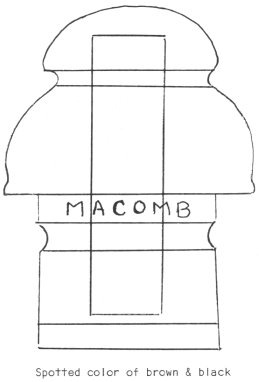
We are looking forward to the visit of Mr. and Mrs. Milholland. There are
about five more insulators I have I want him to inspect.
Keep up the good work -- we all enjoy Crown Jewels,
Thank you very much,
A. L. Rash
Rt. 3, Box 669
Silsbee, Tex. 77565
When you run out of space for your insulators, all you have to do is go out
and shoot yourself a nice big buck deer with lots of points. You not only will
have a good supply of meat, but also a good place to rack some insulators.
Fred C. Koehler
1512 N. Adoline Av.
Fresno, Cal. 93728
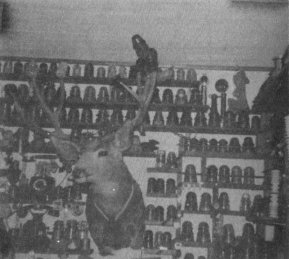
Dear Dora, Editor:
I am sending you some pictures of the light fixtures I have made from
original crossarms. These lights really show off my insulators beautifully.
I have used various colored Hemingray 42's for the reflectors. Small holes
have been drilled in the top of each insulator and then each takes a 15 watt
light.
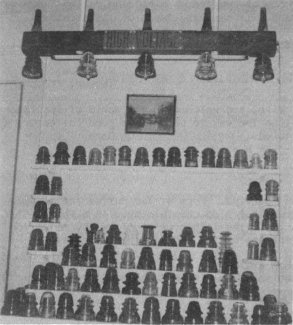
The wiring comes through the pipes from the ceiling, and behind each
cross-arm is a fluorescent lamp with two 40 watt tubes. These lights are all on
one switch.
If you would like any additional information about these lights to share with
the readers of CROWN JEWELS I would be happy to send it to you.
I look forward to my copy of CROWN JEWELS each month, as I find there is
always something new to learn, and this is why I would be happy to share my idea
with other readers.
Sincerely,
Edward Doherty
123 - 14th Ave.
San Mateo, CA
94402
Dear Dora,
I'm at the age of 13, yet it doesn't mean I can't collect insulators. I've
been collecting them for 8 years, but I've only got a few different types,
mainly Hemingray. In those years I collected 312 insulators.
The reason for this letter is that I would like to tell you about an old
catalog found in the ghost town of Sonora. The town had been condemned due to a
mine which was enlarging its pit, and hardly anyone knew about it. Everything
that wasn't of value was left -- that meant we had a few things to look for,
including insulators. Signs of an old General Store were left. We found a
basement full of love letters, etc. Anyhow, we found a catalog called The Mine
& Smelter, supply company. It has many types of illustrations having to do
with insulators, including Westinghouse and Hemingray, even Universal
insulators. It is very interesting, and I'll send some Xerox copies as soon as I
can.
Mike Doe
Tucson, Arizona
Glad to hear from you, Mike, and welcome to the World of Insulators. Sounds
like you're well on the way to becoming a good collector. Much Luck and Success
to you.
Dora
Dear Dora;
Remarks about the postal service. Here at Two Buttes the postal service is
generally good, but I do complain once in a while. I have found that if you go
to the inspector's office (by mail) you will get action. Ask the postmaster who
his inspector is.
And I found one time when I WIRED to the POSTMASTER GENERAL, I really got
action. They sent a man from Colorado Springs, 200 miles, to see me personally.
So it is all right to let your Congressman know, but go to the top of the P. 0.
department for the best results. If everyone who "bitches" would do
this, I'll bet things would get better.
Gerald Brown
RESEARCH DIVISION
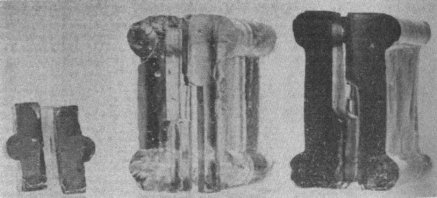
Don Harned's Little Glass Block
These two on the right are regular size glass blocks such as
Frank Jones wrote about in the August '72 Issue of Crown Jewels. Don and I have
been trying to find out the 'whys and wherefores' of this little baby glass
block we acquired about a year ago. So far nothing, except the following
research by Greg Kareofelas. Photo by Kareofelas also. Thanks Greg.
Dora
The following was taken from THE TELEGRAPH IN AMERICA, MORSE MEMORIAL by James D. Reid, 1886.
AMERICAN TELEGRAPHIC HISTORY.
I think it is likely that I used the first iron wire employed on a telegraph
line. One morning just after the line was opened, the copper wire was broken by
a cart bumping against a pole, corner Broad and Callowhill streets,
Philadelphia. Immediately Sam Zook and I started to repair it, for we had no
repairers then. We had no wire. I tried to procure some of the same quality and
metal as that of the line, but could only get some number 14 iron wire from
a tinman, and we supposed that would never do. Neither of us had heard of
Steinheil then. We consulted with lengthened faces what should be done. We
finally concluded to put in the iron wire and see the result. We did so, making
the joints with great care, and hastened to the office. Arriving there, we were
overjoyed to find the line at work. The fact was immediately announced to Mr.
Kendall. Iron wire was soon brought into common use.
The only invention to which I can plead guilty was the construction of a
lightning arrester, by making the current pass through a coarse wire magnet, the
moving beam of which connected at one end with machinery and the other with the
ground. A spring which adjusted the armature above the ordinary current held
tile bar on the brass post connected with the machinery. When a stronger current
appeared the spring was overcome, and the whole charge was thrown off at the
ground post. It worked very well, and Mr. Kendall made it the subject of an
article in the Washington Globe. The Franklin Institute also gave me a silver
medal. Not long after this, however, when we began to understand things better,
David Brooks wrapped a piece of paper round the gas pipe, and by connecting the
main wire thereto, discharged all superfluous lightning. All lightning arresters
are now made on this general plan.
The line from Philadelphia to Baltimore was built in 1846 by Henry O'Reilly,
under a contract for $12,000, increased afterward to $14,000, for a line of one
iron wire. No directions were given about insulation, of which there seemed
little knowledge One curious order was issued. The wires were directed to be
covered with tar! The originator of that sublime conception is unknown! In
conformity with the order, however, a newly-landed Scotchman was engaged, who,
with a tar bucket slung to his side, and a monster sponge in his hand, tarried
the wire as far as Wilmington, Delaware. There tar proved too much for him. He
went to sleep and never woke. We buried him there.
When he was gone no one would take his place. Being then in charge of the men
I took the bucket and the sponge and lathered the electric road to the
Susquehanna. There O'Reilly made a bonfire of my saturated garments. It was a
sad business. All the tavern keepers on that road long remembered the man with
the tar bucket. At the town of North East they would not give me a bed. As I sat
one night on the end of an empty cider barrel, in the bar-room of a small
tavern, bewailing my fragrant condition, and anxiously trying the cleansing
qualities of Sweet Oil, the two plump daughters of the hostess passed me with
signs of unmistakable horror. From another room soon came the exclamation:
" Oh, mother, how that fellow stinks! " How sweet, thought I, is the
Saxon language on the lips of a North East maiden!
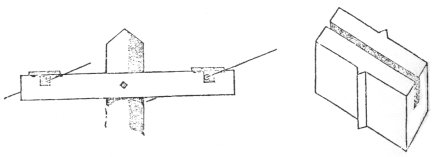
We insulated the wire as directed with bits of India rubber cloth wrapped
round the wire, and wedged in with plugs of Georgia pine. These soon tore out
and as soon as I had authority to act independently, little blocks of grooved
glass of fine quality were substituted.
It is a somewhat curious fact that while F. O. J. Smith, in defiance of all
received views of the necessity of insulation, and the care with which it should
be maintained, issued an order to fasten the wires by iron staples to the bare
poles, Mr. Kendall, at a subsequent period, doubting the possibility of securing
a perfect insulator, recommended the cutting down of every second pole on the
Baltimore division, and which, to some extent, was carried out.
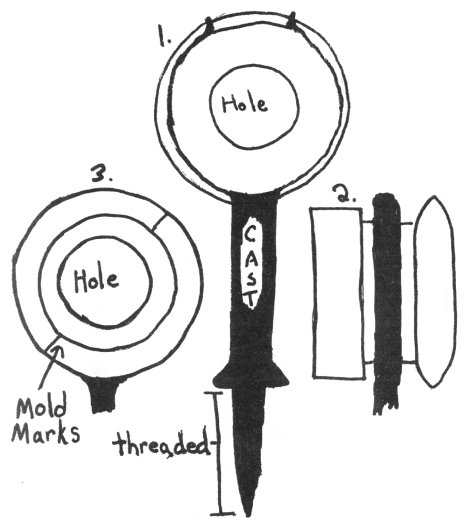
I recently acquired four insulators of the type of which I have made a
sketch. No. 1 view is the back view. I have drawn them as close to actual size
as possible. They are aqua in color and have a cast iron holder which is
threaded on the end. The wire passed through the middle of the Insulator. No. 2
is the side view, which shows the front is larger in diameter than the back and
the middle is the smallest. No. 3 is the front view showing the mold marks. I
would appreciate any information on these and how much they are worth.
Thank You,
John Price
Rt. #4 Graessle Rd,
London, Ohio 43140
P.S. I really enjoy your magazine.
| 